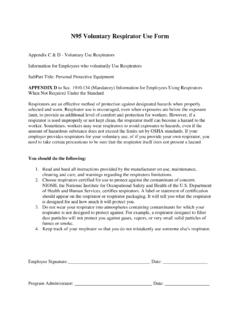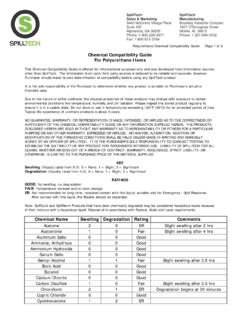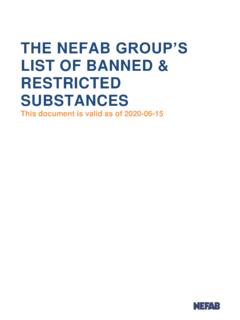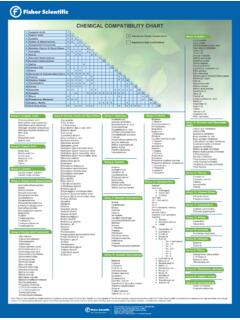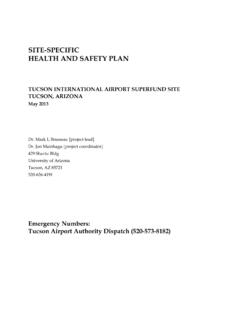Transcription of LABORATORY CHEMICAL WASTE MANAGEMENT …
1 LABORATORY CHEMICAL WASTE MANAGEMENT GUIDELINES Revision: November, 2017 EHRS Environmental Health & Radiation Safety 3160 Chestnut Street, Suite 400 Philadelphia, PA 19104-6287 Contents 1. Overview .. 3 2. When is Hazardous WASTE Regulated? .. 3 3. What is Hazardous WASTE ? .. 3 4. Hazardous CHEMICAL WASTE determination .. 5 5. Essential rules for managing hazardous CHEMICAL materials .. 5 WASTE minimization .. 5 Storing WASTE in the lab (Satellite Accumulation) .. 6 Container MANAGEMENT in SAA s.
2 7 WASTE containers .. 7 Properly labeling WASTE containers .. 7 Why is labeling so important? .. 9 Drain disposal .. 10 Responsibilities and Penalties .. 10 6. WASTE Streams with special procedures .. 10 Unknown materials .. 10 Peroxide forming chemicals .. 11 WASTE oil .. 13 Gas producing WASTE wtreams .. 13 Compressed gas cylinders .. 14 Lecture bottles .. 14 Aldrich Sure Paks .. 15 Mercury containing items .. 15 Mixed WASTE .. 16 Empty containers .. 16 Disposal of chemically contaminated needles & syringes.
3 16 DEA controlled substances disposal .. 17 General Information: .. 17 Lists of controlled substances: .. 17 Disposal procedures: .. 17 DEA Contact Information: .. 18 Refrigerants in equipment .. 18 Battery recycling .. 18 Non-hazardous WASTE disposal .. 18 7. Requesting a CHEMICAL WASTE pickup .. 18 8. WASTE 19 9. Training requirements .. 19 10. Common Federal & State VIOLATIONS .. 20 11. What happens to all of your WASTE ? .. 20 12. CHEMICAL spill procedures .. 20 13. Frequently asked questions.
4 20 14. Lab closeout procedures .. 20 15. Appendices .. 21 Appendix A .. 21 Appendix B .. 21 Appendix C .. 21 1. Overview EHRS is responsible for the development and implementation of proper MANAGEMENT practices for all aspects of the handling, storage, and disposal of CHEMICAL wastes that are generated at the University of Pennsylvania. Our goal is to manage CHEMICAL wastes in a safe and environmentally sound manner that complies with all applicable federal, state and local regulations. 2. When is Hazardous WASTE Regulated?
5 Hazardous WASTE is regulated from the moment it is generated inside the lab until it reaches its final destination for disposal or treatment at an offsite facility. 3. What is Hazardous WASTE ? A hazardous WASTE is a solid, liquid, or gaseous material that displays either a Hazardous Characteristic or is specifically listed by name as a hazardous WASTE . Characteristic wastes are not listed specifically by their CHEMICAL name but they are regulated as hazardous wastes because they exhibit one or more hazardous characteristics.
6 These four characteristics are Ignitability, Corrosivity, Reactivity, and Toxicity. The Ignitability characteristic applies to wastes that are: o Liquids with a flash point less than 140 F o Solids capable of spontaneous combustion under normal temperature and pressure o Oxidizing materials o Ignitable compressed gases o Examples include ethanol, sodium nitrate, hydrogen gas, xylene and acetone The Corrosivity characteristic applies to wastes that are: o Aqueous solutions with a pH less than or equal to 2 or greater than or equal to o This does not apply to solid or non-aqueous materials o Examples include hydrochloric acid, nitric acid, and sodium hydroxide The Reactivity characteristic applies to the following.
7 O Materials that react violently or generate toxic fumes when mixed with water o Cyanide or sulfide bearing wastes which evolve toxic fumes when mixed with acids or bases o Materials that are normally unstable or explosive o Examples include sodium metal, reactive sulfides, potassium cyanide and picric acid The Toxicity Characteristic applies to wastes that have the potential to contaminate groundwater if improperly disposed of. These materials are regulated as hazardous WASTE due to their potential to leach out specific toxic substances in a landfill.
8 There are currently 40 contaminants on the list that include certain heavy metals, pesticides and organic compounds. EPA HW No. Contaminant Level (mg/L) EPA HW No. Contaminant Level (mg/L) D004 Arsenic D024 m-Cresol D005 Barium D026 Cresol D006 Cadmium D027 1,4-Dichlorobenzene D007 Chromium D028 1,2-Dichloroethane D008 Lead D029 1,1-Dichloroethylene D009 Mercury D030 2,4-Dinitrotoluene D010 Selenium D031 Heptachlor D011 Silver D025 p-Cresol D012 Endrin D032 Hexachlorobenzene D013 Lindane D033 Hexachlorobutadiene D014 Methoxychlor D034 Hexachloroethane D015 Toxaphene D035 Methyl ethyl ketone D016 2.
9 4-D D036 Nitrobenzene D017 2,4,5-TP Silvex D037 Pentachlorophenol D018 Benzene D038 Pyridine D019 Carbon tetrachloride D039 Tetrachloroethylene D020 Chlordane D040 trichloroethylene D021 Chlorobenzene D041 2,4,5-Trichlorophenol D022 Chloroform D042 2,4,6-Trichlorophenol D023 o-Cresol D043 Vinyl chloride What is a listed Hazardous WASTE ? Unused or unopened chemicals will meet the definition of a listed hazardous WASTE if they appear on one of two lists.
10 The U-list contains materials that are hazardous due to their toxicity. The P-list contains materials that are hazardous because they are acutely toxic. These lists only apply to unused materials that have one of the listed chemicals as the sole active ingredients. The list also applies to spill cleanups of these unused materials. The complete U and P lists are included in Appendix A and B of this manual. Additionally, certain used or spent solvents can be regulated as a hazardous WASTE if they appear on the F-list.

